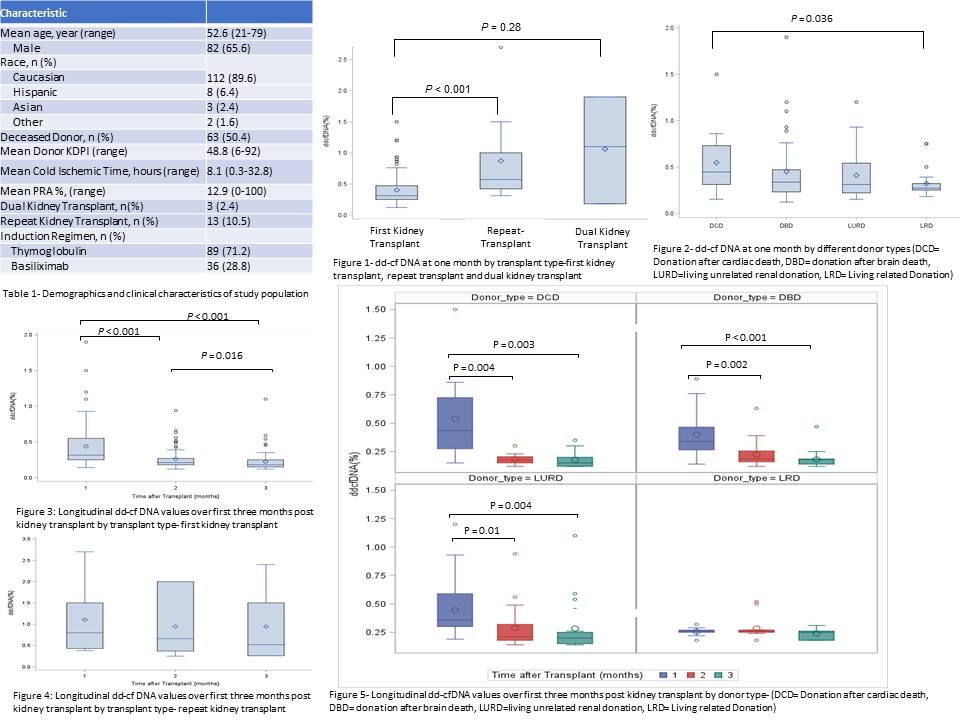Longitudinal Variance of Donor Derived Cell Free DNA (dd-cf DNA) in Stable Kidney Transplant (Tx) Patients are Influenced by Donor/Recipient Variables
Intermountain Medical Center, Murray, UT
Meeting: 2021 American Transplant Congress
Abstract number: 628
Keywords: Kidney
Topic: Clinical Science » Biomarkers, Immune Assessment and Clinical Outcomes
Session Information
Session Name: Biomarkers, Immune Assessment and Clinical Outcomes
Session Type: Poster Abstract
Session Date & Time: None. Available on demand.
Location: Virtual
*Purpose: The limits and cut offs of dd-cfDNA as an injury biomarker in kidney transplant (KTx) are based on coupled single event (biopsy) measurements. It represents an oversimplification that extrapolates from a single measurement to prospective repeat measures. Meaningful interpretation of repeat measures of dd-cfDNA demands : 1) factors determining biologic variability; 2) time variance of dd-cfDNA levels post-Tx; and 3) relationship to donor and recipient characteristics. We hypothesized that incorporating knowledge of the above factors would refine the clinical utility of the use of dd-cfDNA as an injury biomarker by better selection of patients for further intervention.
*Methods: After excluding patients with biopsy proven acute rejection, a total of 125 patients who underwent kidney transplantation between 1st June 2016 to 31st December 2019 had serial dd-cfDNA samples obtained at months 1, 2, 3, 4, 6, 9 and 12 post-transplant as part of their standard of care.
*Results: 82 (65.6%) participants were male, with a mean age of 52.6 (Table 1). Median dd-cfDNA at 1 month post-Tx was higher in repeat KTx (0.57%, p < 0.001), and dual KTx (1.10%, p = 0.28) versus a single KTx (0.31%) (Fig 1). A decreasing and significant trend was observed in median dd-cfDNA at 1 month post-Tx for patients receiving a kidney from donor after cardiac death (DCD [0.45%]), donor after brain death (DBD [0.37%]), living unrelated (LURD [0.34%]) or living related (LRD [0.27%]) donors (p=0.036)(Fig 2). Longitudinal, repeated dd-cfDNA measurements showed a significant decrease over time during the first three months after transplantation for first KTx (p<0.001) (Fig 3). For re-Tx (n=7), there was a non-significant downtrend of dd-cfDNA over time (Fig 4). Sub-group analysis, by donor-type, showed a significant downtrend in dd-cfDNA values recipients with DCD, DBD, LUKT showed from one month to three months (p<0.05) (Fig 5). Panel-reactive antibodies (PRA) were positively correlated with dd-cfDNA (R2 = 0.113, p < 0.001).
*Conclusions: Repeat Tx, Dual Tx and higher PRA are associated with a higher dd-cfDNA likely a function of the size of the dd-DNA source. Values of dd-cf DNA at one month are likely higher at baseline, attributable to initial ischemia reperfusion injury. dd-cfDNA should be interpreted with caution in certain donor types (DCD, DBD, LUKT). Incorporation of donor/recipient variables and time down dependent evolution post transplant is material for rational interpretation of ddcfDNA cutoffs in clinical decision making.
To cite this abstract in AMA style:
Anand S, Lopez-Verdugo F, Sanchez-Garcia J, Dong L, Fife M, Krong J, Morris D, Srinivas T. Longitudinal Variance of Donor Derived Cell Free DNA (dd-cf DNA) in Stable Kidney Transplant (Tx) Patients are Influenced by Donor/Recipient Variables [abstract]. Am J Transplant. 2021; 21 (suppl 3). https://atcmeetingabstracts.com/abstract/longitudinal-variance-of-donor-derived-cell-free-dna-dd-cf-dna-in-stable-kidney-transplant-tx-patients-are-influenced-by-donor-recipient-variables/. Accessed December 26, 2025.« Back to 2021 American Transplant Congress

